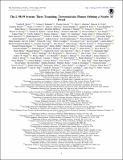The L 98-59 system: three transiting, terrestrial-size planets orbiting a nearby M dwarf
Author(s)
Matthews, Elisabeth; Ricker, George R.; Vanderspek, Roland K.; Seager, Sara; Burke, Chris; Crossfield, Ian; Shporer, Avi; ... Show more Show less
DownloadPublished version (6.110Mb)
Publisher Policy
Publisher Policy
Article is made available in accordance with the publisher's policy and may be subject to US copyright law. Please refer to the publisher's site for terms of use.
Terms of use
Metadata
Show full item recordAbstract
We report the Transiting Exoplanet Survey Satellite (TESS) discovery of three terrestrial-size planets transiting L 98-59 (TOI-175, TIC 307210830) - a bright M dwarf at a distance of 10.6 pc. Using the Gaia-measured distance and broadband photometry, we find that the host star is an M3 dwarf. Combined with the TESS transits from three sectors, the corresponding stellar parameters yield planet radii ranging from 0.8 R ⊕ to 1.6 R ⊕. All three planets have short orbital periods, ranging from 2.25 to 7.45 days with the outer pair just wide of a 2:1 period resonance. Diagnostic tests produced by the TESS Data Validation Report and the vetting package DAVE rule out common false-positive sources. These analyses, along with dedicated follow-up and the multiplicity of the system, lend confidence that the observed signals are caused by planets transiting L 98-59 and are not associated with other sources in the field. The L 98-59 system is interesting for a number of reasons: the host star is bright (V = 11.7 mag, K =7.1 mag) and the planets are prime targets for further follow-up observations including precision radial-velocity mass measurements and future transit spectroscopy with the James Webb Space Telescope; the near-resonant configuration makes the system a laboratory to study planetary system dynamical evolution; and three planets of relatively similar size in the same system present an opportunity to study terrestrial planets where other variables (age, metallicity, etc.) can be held constant. L 98-59 will be observed in four more TESS sectors, which will provide a wealth of information on the three currently known planets and have the potential to reveal additional planets in the system. ©2019
Date issued
2019-07Department
MIT Kavli Institute for Astrophysics and Space ResearchJournal
Astronomical journal
Publisher
American Astronomical Society
Citation
Kostov, Veselin B., et al., "The L 98-59 system: three transiting, terrestrial-size planets orbiting a nearby M dwarf." Astronomical journal 158, 1 (2019): no. 32 doi 10.3847/1538-3881/AB2459 ©2019 Author(s)
Version: Final published version
ISSN
1538-3881